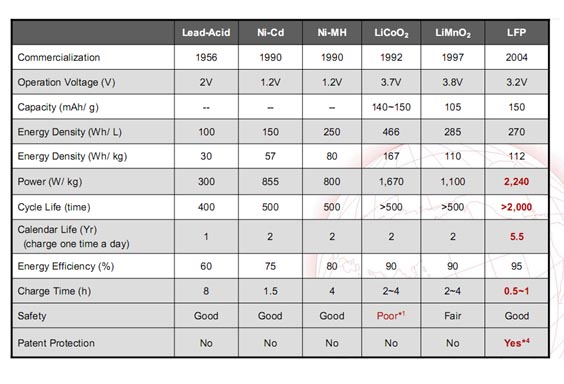|
 |
|
|
Safe and efficient power supply solutions
----LFP Batteries for customized power supply solutions
| Introduction |
| |
Why LFP Battery?
1.Safety:Will not explode or catch fire.
2.Green Product:Recyclable, non-toxic material, ECO friendly, RoHS certified.
3.Light Weight:Weighs 1/3 of lead acid batteries of same capacity.
4.
95% Energy Efficiency:Energy transformation efficiency is as high as 95%, while that of conventional Lead-Acid batteries is 60%.
5.
Long Life Cycles:Over 2000 cycles ( > 6 years if charged daily )
6.
Fast Charging Capability:Eight times faster than lead-acid batteries; 85% full in less than 30 minutes.
7.
Higher instant peak power:Retrieve instant high power for starting motors or other high power machinery.
8.
Wider Voltage Range:Easy to install, can be connected to systems of different voltages.
9.
Wide working temperature: -20oC to + 80oC
10.
No memory effects. |
 |
| |
|
| LFB vs. Lead Acid batteries and other lithium ion batteries |
Battery Type
Military Benefit |
LFP |
Fuel Cell |
Limn |
LiCo |
Ni-Mh |
Ni-Cd |
lead acid |
|
Safety |
Good |
Weak |
Marqinal |
Poor |
Adequate |
Adequate |
Adequate |
Extreme Environ. Resistance |
Good |
Marqinal |
Poor |
Weak |
Marqinal |
Marqinal |
Marqinal |
Logistic/ Maintain Cost |
Good |
Poor |
Adequate |
Adequate |
Adequate |
Adequate |
Weak |
Damage Resistance |
Good |
Poor |
Weak |
Poor |
Weak |
Weak |
Marqinal |
Heavy Power Load? |
Good |
Good |
Poor |
Poor |
Weak |
Weak |
Poor |
Capacity (Wh/ L) |
Adequate |
Good |
Adequate |
Good |
Marqinal |
Weak |
Poor |
Quick Charge |
Good |
Good |
Weak |
Weak |
Weak |
Weak |
Poor |
Cycle Life |
Good |
Adequate |
Marqinal |
Marqinal |
Weak |
Weak |
Poor |
Environ. Friendly |
Good |
Good |
Adequate |
Weak |
Weak |
Poor |
Poor |
|
| |
Good |
|
Adequate |
|
Marqinal |
|
Weak |
|
Poor |
|


Application

Safety:
Lead acid batteries emit hydrogen (which can catch fire) that has to be removed if operating in closed environments (i.e. submarines). The liquid in lead acid batteries can spill over and cause corrosion; the liquid also can freeze at low-temperatures conditions and an electric warmer must be installed (more logistical burden and consumes power). Other lithium ion batteries may not have the problem of sulfuric acid, but they tend to explode or catch fire especially under high current operations.
LFP battery has none of those problems. It is stable under high current charge/discharge. In a lab test, it was proven to pose no danger of explosion/fire or emission of harmful gas even when intentionally overcharged under high current (bypassing safety circuits) or crushed by 10 tons of pressure. (Lab test document available).
Fast charge/discharge:
Lithium ferret batteries have the fastest charging time of all batteries. It can reach 85% capacity within 30 minutes and 100% in an hour while lead acid batteries would take up to 8 hours. Even other lithium ion batteries do not perform nearly as well, and they are prone to fire/explosion under high current operation. For a submarine this advantage can mean difference between life and death.
Cycle life:
Assuming one charge per day, led acid batteries last about 2 years while LFP batteries can last 5-6 years—tremendous savings in logistics, especially for hard-to-supply locations (inside a submarine, remote radar sites..).
Logistical burden:
LFP batteries have energy density 2.7 times better in volume and 3.7 times in weight than that of lead acid batteries. In terms of W/kg ratio, LFP batteries are eight times better than lead-acid batteries. In addition, LFP batteries last three times longer than lead-acid batteries. And unlike lead-acid batteries, our batteries require virtually no maintenance. Switching to LFP batteries will greatly reduce logistical burden.
LFB vs. Fuel cell
Efficiency:
-Fuel cell is NOT green:
“The efficiency of a fuel cell is dependent on the amount of power drawn from it. Drawing more power means drawing more current, which increases the losses in the fuel cell. As a general rule, the more power (current) drawn, the lower the efficiency” “For a fuel cell operating on air (rather than bottled oxygen), losses due to the air supply system must also be taken into account. This reduces the efficiency significantly and brings it near to that of a compression ignition engine. Fuel cell
vehicles running on compressed hydrogen may have a power-plant-to-wheel efficiency of 22% if the hydrogen is stored as high-pressure gas, and 17% if it is stored as liquid hydrogen”.
Safety is big concern:
- All fuels suitable for use in cells catch fire easily and present a significant danger of fire and explosion.“The Health and Safety Executive (HSE) has published a new guidance booklet on the hazards associated with fuel cells and the fuels they use. All fuels suitable for use in cells catch fire easily and present a significant danger of fire and explosion. Materials such as these are called 'dangerous substances' under the Dangerous Substances and Explosive Atmospheres Regulations 2002
(DSEAR). (http://www.hse.gov.uk/press/2004/e04022.htm)”
Complex logistics:
Fuel cells require complex logistics. A regular unit would not have the capability to refuel (liquid hydrogen is difficult to handle), while LFP batteries can be recharged anywhere with a power outlet. And the fuel for the fuel cells (hydrogen, alcohol, methane or others) is generally unsafe for transportation and storage.
|
|
|
|
|
|
 |





























